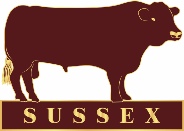SUSSEX TODAY
The modern Sussex is a highly economical, well muscled, easy and economical to produce animal giving the best quality beef.
This is not an idle boast – the data proves it – our breeders are actively encouraged to subscribe to Signet Beef Breeder and to use their BLUP reports to assist in selecting and improving their breeding stock.
In over 20 years, growth at 400 days has increased. Muscling has also increased proportionately. Fat Depth is appropriately balanced against the two to maintain beef quality. SIGNET BEEFBREEDER GENETIC TRENDS DATA proves the fact that the breed is no longer described as small and fat!
What is this worth in today’s market? The average Sussex bull is now siring calves worth significantly more than the average bull in 1980. Assuming 130 calves sired in a lifetime this adds substantial commercial value of Sussex bull going into a commercial herd.
With the great improvements in carcase and growth traits we have maintained the important maternal breed traits of calving ease, milkiness, temperament and the ability to thrive on a low input/extensive system of management.
For economical beef production look no further than the SUSSEX combining the best of the past with modern, commercial requirements.
BUT IT IS NOT JUST THE SOCIETY’S WORD THIS IS WHAT BREEDERS HAVE TO SAY
“The Sussex is an extremely good forage converter – it seems to live on little.”
“My aim is to keep costs as low as possible by using home grown forages. We have increased our grassland by 100 acres to enable us to raise cattle with less concentrate. This has also allowed us to increase our income from selling corn.”
“In the second half of winter, we feed some creep to autumn-
“Cows are also used as part of the arable rotation. “After winter barley we plant a turnip crop, which is grazed by the spring calvers.”
“Despite cow numbers increasing by 25%, we are using less rolled corn and concentrate over the same period than we were 10 years ago.”
“With a native breed growth rates may not be as good, but this is easily balanced out by reduced costs.”
“The fact the Sussex is so easy to look after means my stockman can be responsible for 500 head and also bale and drill on the arable enterprise, which cuts costs further.”
“A lot of land in this area is in ELS or HLS. As a result we need cattle that can graze marshland efficiently and maintain the environment. We put cows out on marshland made almost entirely of rushes and they grazed down highly efficiently and got the grass growing again.”
“Any cows not in calf after eight weeks go to the fat market -
“With limited labour we can’t afford to spin out our calving pattern and using this policy 85% of our cattle calve in the first three weeks and 15% in the latter. With some 50 Sussex cattle it would be unusual if more than two or three weren’t in calf after two cycles with the bull.”
“Another advantage of the Sussex is their ease of calving. This year we only intervened once and for the last two years we have not lost a single calf, which at the end of the day makes a significant impact on the bottom line”.
“The modern Sussex offers a hardy, docile animal but one that can be pushed fairly hard without getting too fat. On that basis the Sussex herd represent a profitable enterprise”.
“The most recently killed steer was sixteen months old, live weight 478kg, dead weight 260kg (54%) producing 171kg of sellable meat. In the farm shop, this retailed for £1435 representing a significant profit once all costs had been accounted for.”
“This extensive system works well here on the Kent marshes. The Sussex cows we have here are very hardy requiring little input in return for an annual live calf. Last
year we put 94 cows to our Sussex bulls of which 12 were heifers. Of these two were empty, and of the other 92 we had 100% live calves with just 3 assists, one major and two tugs. With this level of fertility and self sufficiency, our Sussex suckler herd fits very well into this busy farm where all too often there seem to be more pressing things to attend to”.
“The modern Sussex provides a useful combination of a thrifty, docile, milky cow producing offspring which can be pushed hard to finish at 10-
SUSSEX COWS AND BULLS ARE AN ECONOMIC ASSET TO ANY HERD A GREAT BRITISH BEEF BREED PRODUCING
GREAT BRITISH BEEF
SUSSEX CATTLE SOCIETY
